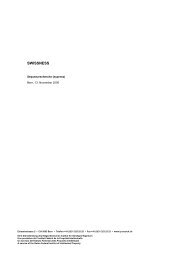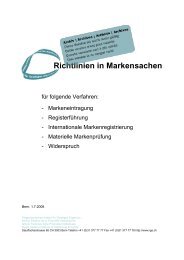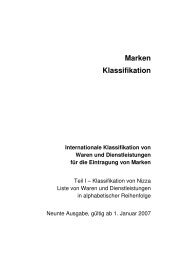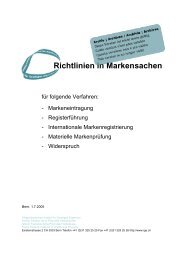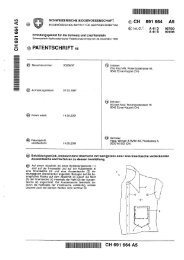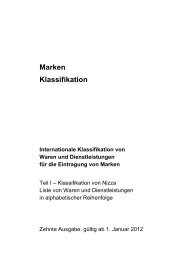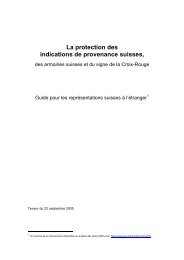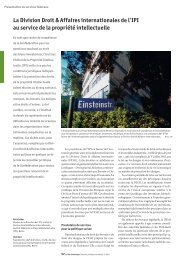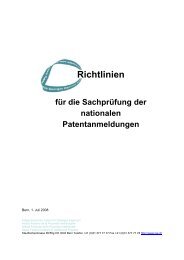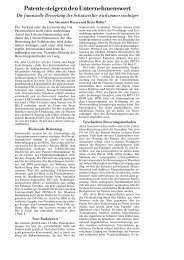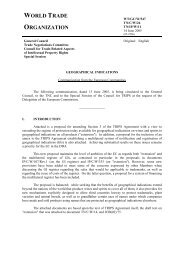AVIS DE DROIT PROTECTION DES SIGNES NATIONAUX
AVIS DE DROIT PROTECTION DES SIGNES NATIONAUX
AVIS DE DROIT PROTECTION DES SIGNES NATIONAUX
Create successful ePaper yourself
Turn your PDF publications into a flip-book with our unique Google optimized e-Paper software.
d) Protection des signes nationaux<br />
(i) National Insignia Used as Trademarks<br />
IRLAN<strong>DE</strong><br />
Irish law as contained in the Industrial and Commercial Property (Protection) Act 1927, the<br />
Trade Marks Act 1996 and the Trade Marks Rules 1963 is very similar to that prevailing<br />
under British law (refer below, to the national report entitled “Royaume-Uni), except that<br />
royal emblems and arms are not protected as such. On the other hand, protection is afforded to<br />
all the flags, emblems, badges and similar devices of all States, municipalities, institutions,<br />
societies, bodies corporate and other persons, in that these will not be registered unless the<br />
applicant for registration can satisfy the Registrar that he has obtained permission from the<br />
person or authority that is entitled to give it. The only national insignia specifically mentioned<br />
as protected in this context is the Irish shamrock, or clover associated by legend with St.<br />
Patrick, which may not be registered as a word or as a graphic representation.<br />
(ii) National Insignia Used as Company or Business Names<br />
Under sec. 21 of the Companies Act 1963 and subsec. 14(1) of the Registration of Business<br />
Names Act 1963, the relevant Minister may refuse the registration of “undesirable” business<br />
or company names. No indication is given of what kind of names are “undesirable”.<br />
(iii) Other Commercial Use of National Insignia<br />
Irish law as contained in the Consumer Information Act 1978 is effectively the same as that<br />
prevailing under British law (refer below, to the national report entitled “Royaume-Uni), with<br />
respect to the misuse of false trade descriptions.<br />
As concerns the use of origin labels, imported jewellery bearing characteristically Irish<br />
designs or symbols may not be offered for sale in Ireland unless it bears an indication of the<br />
foreign country in which it was made; Merchandise Marks (Restriction on Sale of Imported<br />
Jewellery) Order 1971. Part II of the schedule to that subsidiary legislation contains an<br />
extensive list of places, people and things which, when attention is directed to them in any<br />
way, are considered to be characteristic of Ireland.<br />
Irish law does not offer general protection to the names, uniforms, badges and membership<br />
designations of public interest associations (compare the national report entitled “Royaume-<br />
Uni, below), but does restrict commercial use of flags, emblems, badges and other devices<br />
that are identified with the Irish State or any of its government departments or officials. A<br />
person who makes commercial use of these with the calculated intention of misleading people<br />
into believing that he is authorised to use them, commits a criminal offence; Industrial and<br />
Commercial Property (Protection) Act 1927, sec. 151.<br />
The extended form of civil liability for “passing off” goods as having similar characteristics to<br />
those of a class of manufacturers, established by the British House of Lords in respect of<br />
“advocaat”, also exists in Ireland 171 , which applies the same principles of common law. Refer<br />
below, to the national report entitled “Royaume-Uni”.<br />
171 Refer to Clark, R. & Smyth, S, Intellectual Property Law in Ireland (Tottel Publishing, 2 nd ed, 2005),<br />
paras. [25.16] et seq. and to the Irish jurisprudence cited there.<br />
113



